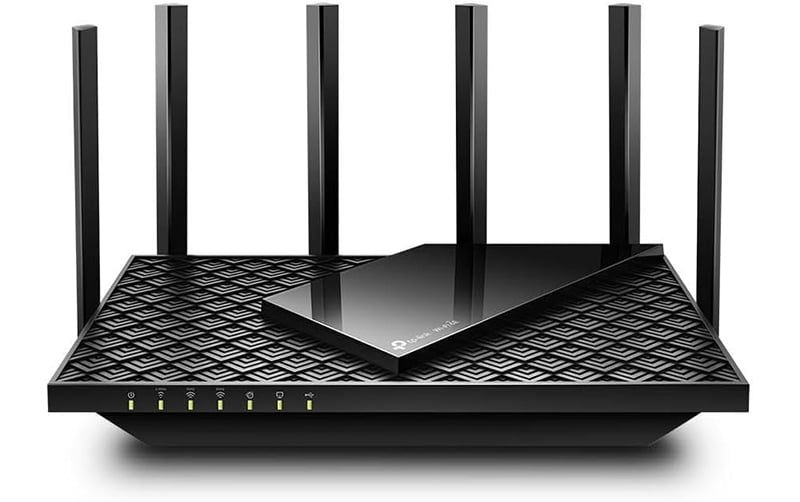Wireless routers provided with broadband deals are often updated, but for older customers, or those with a more basic provider, upgrading the router can mean faster speeds.
New router technology offers the latest wireless 7 protocol, along with stronger antennae for boosted coverage and more flexible options for mesh boosters too.
Here we'll look at the top three routers for full fibre broadband or Virgin Media cable to help improve coverage and speeds around the home.

Which wireless router should I choose?
Many broadband providers invest in keeping up with the latest wireless router technology, however, it can also take time for new models to come out, and often these can be reserved for the most expensive packages.
That means upgrading the router may be a good option for:
- people with a cheaper broadband deal that doesn't come with the provider's latest router, which can include Virgin Media, or
- people signed up to a budget broadband provider who only offers a very basic router, or where they still use older technology, like Onestream, Plusnet and even BT
Not all wireless routers will be suitable for all broadband connections however, with a distinction in the technology required for those in part fibre areas compared to those with a full fibre or cable connection.
So, in this guide we'll look at two main types of router:
- Non-DSL routers which don't have a modem built-in, and are the routers needed for people with full fibre to the home or Virgin Media cable connections
- DSL or VSDL modems, which are required for those on older part fibre connections, including superfast plans from providers like BT, Plusnet, and TalkTalk
Non-DSL routers are likely to offer the most up to date technology as full fibre aims to become the standard broadband connection across the UK. For example, BT, or Openreach, full fibre broadband has now passed over 16 million premises, or 50% of the UK, while Virgin Media passes over 18.3 million, or over 60% of UK homes.
Those who can get full fibre broadband but have yet to upgrade should also consider doing that to help boost broadband speeds before shelling out on a new router, especially as many packages will come with an upgraded router too.
Router specifications
The main specifications to look at when comparing wireless routers are:
- WiFi protocol, with WiFi 7 offering the latest technology
- Wireless bands, with dual band the most common, but some devices also offering tri-band for increased coverage and speeds
- Security protocol, with WPA3 offering the most up to date encryption
- Maximum speed, and, or, antennae strength
- Mesh support, to easily extend the network with additional boosters
While the latest WiFi standard is 7, or 802.11be, it was only released in 2024 and so many connecting devices, like computers, tablets and smartphones are unlikely to support it yet.
Therefore, WiFi 6 routers are currently much more common, and still offer good value for money with markedly improved wireless performance over WiFi 5, with around a 30% boost in speeds.
For WiFi 7 to be of benefit, customers will need the very latest devices. Here's a quick rundown of various WiFi supported devices:
| WiFi support | |
|---|---|
| iPhone 16 series | 7 |
| Google Pixel 8 and 9 series | 7 |
| Samsung Galaxy S24 Ultra | 7 |
| iPhone 15 Pro & Pro Max | 6E |
| iPhone 11 to 15 | 6 |
| Samsung Galaxy S10 and S20 | 6 |
| PlayStation 5 | 6 |
| Sky Glass 2nd gen | 6 |
| Sky Stream Box | 6 |
| Virgin Stream Box | 5 |
| Xbox Series X/S | 5 |
| Nintendo Switch | 5 |
So, only those with the very latest devices released in 2024 are likely to offer any support, and therefore any benefit, for WiFi 7.
That said, all routers are backwards compatible with previous WiFi protocols, so devices that support WiFi 6 will be able to connect using this protocol on a router that supports WiFi 7, so the increased investment could be worthwhile to remain more future proof if you're likely to be upgrading many home devices in the near future.
Best router for full fibre broadband
Full fibre broadband routers, like these below, connect to the ONT box installed by the provider, or in the case of Virgin Media, they'll connect to the Virgin Media router placed into modem mode.
Best wireless router upgrades for full fibre and cable broadband
| TP-Link Archer AXE75 | Netgear Nighthawk RS300 | Linksys Velop Micro 6 Mesh System | |
|---|---|---|---|
| Price | £109.97 | £239.98 | £267.97 |
| Maximum WAN broadband speed | 1Gb | 2.5Gb | 2.5Gb |
| WiFi protocol | 6E | 7 | 6 |
| WiFi band | Tri-band | Tri-band | Dual-band |
| Maximum wireless speed | 5.4Gb | 9.3Gb | 3Gb |
| Mesh support | Yes | Yes | Yes - includes 2 mesh nodes |
| Security | WPA3 | WPA3 | WPA3 |
| Ethernet LAN | 4 x 1Gb | 2 x 2.5Gb + 2 x 1Gb | 4 x 1Gb |
1. TP-Link Archer AXE75
Chosen for: Support for WiFi 6E and tri-band wireless channels at an affordable price.
| Pros | Cons |
|---|---|
| Additional 6GHz wireless channel for increased bandwidth and performance benefits | Only supports broadband plans up to 1Gb per second |
| Support for OneMesh, with TP-Link mesh boosters available from £25 | |
| Alexa voice control | |
| HomeShield security, including parental controls with custom profiles |

The TP-Link Archer AXE75 is one of top router choices for those with full fibre or Virgin Media cable broadband. Although it is limited to receiving connection speeds of up to 1Gbps, so it's not suitable for multi-gigabit packages.
It provides support for WiFi 6E, which is essentially WiFi 6 but with an additional 6GHz channel, which drastically reduces congestion and interference often found on the 5GHz channel and is dedicated to WiFi 6E supporting devices.
However, like WiFi 7, fewer devices support WiFi 6E so far, although this does include:
- Smartphones: Apple iPhone 15 Pro and Pro Max, Google Pixel 6, Samsung Galaxy S22 Ultra, Xiaomi Mi 11 Ultra
- Laptops: Apple Macbook Pro 2023, Lenovo ThinkPad X1 Extreme Gen 4, Acer Predator Triton 500 SE
- Tablets: Apple iPad Pro 11-inch (4th gen), iPad Pro 12.9-inch (6th gen)
Effectively, you're looking at devices released from at least 2021 onwards.
While the TP-Link Archer AXE75 only supports broadband packages up to 1Gbps, the router is capable of delivering wireless speeds of up to 5.4Gbps when utilising the WiFi 6E protocol.
Connection
The TP-Link Archer AXE75 requires a WAN connection to either an external modem or an ONT box, in the case of full fibre broadband. Virgin Media cable customers will need to switch their Hub to modem-only mode and then connect to that.
Set-up should be a simple process however, with a dedicated Tether app available for iOS or Android devices, as well as a web-based interface.
The app provides notifications for any newly connecting device, security settings, and parental controls with custom profiles that can group devices by person.
For wired connections the TP-Link Archer AXE75 houses four additional 1Gb Ethernet LAN ports, as well as one USB 3.0 port.
Coverage
TP-Link say the Archer AXE75 is suitable for a two to three-bedroom house. It has six fixed external antennae, and supports beamforming, which focuses the sending signal towards connecting devices to improve range.
Of course, it's possibly to easily extend coverage with the built-in support for OneMesh, and additional TP-Link mesh devices can be purchased from as little as £25. Mesh extends a wireless network seamlessly, so the login details stay the same and devices can simply move around the home while remaining connected to the same network.
Technical speeds available with the TP-Link Archer AXE75 are up to 5.4Gbps, however this is split over the three channels, such as:
- 6GHz: 2402Mbps
- 5GHz: 2402Mbps
- 2.4GHz: 574Mbps
So, older devices, connecting with only WiFi 6 or WiFi 5, will only be able to access speeds up to 2.4Gbps, while WiFi 6E devices will be able to benefit from the full 5.4Gbps support. Yet, bear in mind, this router only supports fixed-line broadband connections up to 1Gbps.
Security
One of the most important features of a router is how secure it is. The TP-Link Archer AXE75 supports the latest WPA3 internet security encryption, while also offering a built-in security suite with advanced parental controls.
HomeShield security protects connecting devices, including smart speakers and smart home tech, from attacks, as well as blocking access to malicious websites.
One of the major benefits of HomeShield for families is the advanced parental controls, which allow individual profiles where devices can be grouped by user, with settings customised for their age.
2. Netgear Nighthawk RS300
Chosen for: Multi-gigabit broadband packages up to 2.5Gbps, with the latest support for WiFi 7 devices.
| Pros | Cons |
|---|---|
| Supports the latest WiFi 7 technology with speeds up to 9.3Gbps | Subscriptions for some security and additional parental control features |
| Works with multi-gigabit broadband plans up to 2.5Gbps | |
| Includes two 2.5Gbps Ethernet LAN ports |

While Netgear promote the Nighthawk routers as ideal for gaming, they also make great home devices simply for those who want a faster wireless experience.
The latest Nighthawk range starts with the RS200 for £199, which supports dual-band WiFi 7 and offers wireless speeds of up to 6.5Gbps. However, we've chosen the next model up, the RS300, which costs a little more at £239.99, but also supports the WiFi 6E 6GHz channel and offers tri-band connections, so more of the newest devices will be supported and have the option of less interference on the new band.
This is a great router option for those with multi-gigabit broadband connections, because as well as offering a 2.5Gbps Internet WAN port, the router also houses two 2.5Gbps Ethernet LAN ports for seriously fast wired connections.
The multi-gigabit LAN ports are an ideal way to experience faster broadband speeds to smart TVs and gaming consoles without also needing devices supporting the latest WiFi standards.
The Netgear Nighthawk RS300 supports WiFi 7, but like the TP-Link Archer AXE75 we looked at above, support will be limited for the absolute newest devices.
WiFi 7 was released only in 2024, and so few devices except for the very latest smartphones, including the iPhone 16 series, Google Pixel 8 and 9 series, and Samsung Galaxy S24 Ultra, support it. That said, the Netgear Nighthawk RS300 is also backwards compatible and so will also offer connections over WiFi 6 and WiFi 6E too.
Connection
The Netgear Nighthawk RS300 and upwards range of routers are designed for full fibre to the home broadband connections, and can also be used by Virgin Media cable customers by adjusting their Virgin Hub to work in modem-only mode.
To setup the router customers can use the Nighthawk app on either iOS or Android, and this also allows for control over connecting devices and a built-in Internet speed test.
The Nighthawk RS300 supports broadband packages with speeds up to 2.5Gbps, which would cover plans like Virgin Media Gig2 as well as Vodafone's Full Fibre 1.6 and 2.2 options on Openreach and CityFibre.
While the Nighthawk RS300 can connect up to 100 devices simultaneously, for wired connections in the home, the RS300 houses two multi-gigabit 2.5Gbps LAN ports as well as two additional 1Gbps LAN ports. There is also one USB 3.0 port.
Coverage
The Netgear Nighthawk RS300 can cover up to 2,000 square feet, or 185 square meters, with a 360-degree antenna design.
There is also support for mesh, which can seamlessly extend the network even further, with Netgear offering mesh boosters from £50 for a WiFi 6 model covering an additional 2,100 square feet.
One of the main benefits of opting for the RS300 over the slightly cheaper RS200 is the additional 6GHz wireless channel, which offers WiFi 6E support and helps to boost maximum wireless speeds from 6.5Gbps to 9.3Gbps. The three channels cover:
- 6GHz: Up to 5800Mbps
- 5GHz: Up to 2900Mbps
- 2.4GHz: Up to 700Mbps
These faster speeds will undoubtedly be beneficial to anyone with newer WiFi 6E and WiFi 7 devices, as well as those with multi-gigabit broadband plans.
Security
The Netgear Nighthawk RS300 router comes with a level of security built-in, including support for the latest WPA3 security encryption.
In terms of protection for the home network, there is a built-in firewall, guest network option, VPN, and automatic firmware updates.
However, some of the more advanced security features are found within Netgear Armor, a paid-for subscription service powered by Bitdefender, which includes real-time hacking protection, virus and malware protection, as well as a mobile app for up to 50 devices.
Netgear Armor is free for 30-days and then costs around £100 a year. While it does offer more features than TP-Link's HomeShield, users might be frustrated to have to pay for some of the tools, including the additional cost for upgraded Parental Controls at an extra £5 per month.
3. Linksys Velop Micro 6 Mesh WiFi System
Chosen for: Larger homes that want an affordable whole home WiFi system for the greatest coverage.
| Pros | Cons |
|---|---|
| Includes router and two mesh nodes, covering up to 465 square meters | Ethernet LAN ports limited to 1Gbps |
| Supports multi-gigabit broadband connections, up to 2.5Gbps | Mesh nodes offer no additional wired connections |
| Affordable whole home mesh system with three devices |

The Linksys Velop Micro 6 mesh WiFi system is an all-in-one kit for homes that want the extended coverage offered by mesh out of the box.
While the TP-Link Archer and Netgear Nighthawk routers both support mesh, users will have to purchase additional devices, while this kit from Linksys includes a router plus two mesh boosters, and covers a total of 465 square meters, or 5,000 square feet.
Linksys themselves promote the Velop Micro 6 range as being affordable, and compared to other mesh kits, which tend to cost from £500, it is.
Despite only supporting up to WiFi 6, the Velop Micro 6 range will be more than adequate for most households, with few devices supporting the latest 6E and 7 protocols in any case. It also helps keep the price point lower.
There is a 2-pack kit available with just the router and one node for £199, however, it works out cheaper to buy the nodes you're likely to need upfront, as they cost just over £100 to buy individually.
The system itself offers support for WiFi 6, and while Ethernet LAN ports are limited to 1Gbps, the Internet WAN port supports broadband connections up to 2.5Gbps.
These are neat looking devices, housed in small, plain white, cases without any external antennae, which will be attractive to most homes that want good wireless signal, but who don't necessarily need the absolute latest WiFi technology.
Connection
Setup of the Linksys Velop Micro 6 mesh system is simple and straightforward, with users only needing to plug the devices in and then scan a QR code to connect to WiFi.
There is of course, still a Linksys app that can be used to manage the network, including seeing connected devices and mesh nodes, Internet speed, and parental controls.
The Linksys Velop Micro 6 router supports broadband connections up to 2.5Gbps, so larger households who want really fast speeds can sign up to the fastest packages.
Users can connect up to 150 devices simultaneously, with wireless speeds available up to 3Gbps.
One thing to note is that while the Velop Micro 6 router houses four 1Gbps Ethernet LAN ports, the nodes purely offer WiFi only, with no additional LAN ports.
Coverage
Linksys say the Velop Micro 6 router should provide up to 2,500 square feet of coverage, with an additional 1,500 square feet of coverage per node.
While the Linksys Velop Micro 6 doesn't boast the same top speeds as the TP-Link Archer AXE75 or the Netgear Nighthawk RS300, it still offers up to 3Gbps over WiFi 6.
Most households will find their devices support either WiFi 5 or WiFi 6, which was released in late 2019.
Devices that support WiFi 6 include the Sky Stream Box, Sky Glass and Sky Glass 2nd Gen, PlayStation 5, iPhone 11 series onwards, and Samsung Galaxy S10 and S20 onwards.
Some well-known devices, including the Xbox Series S/X, Virgin Stream Box and Nintendo Switch still only support WiFi 5, so even WiFi 6 is fairly new.
This does mean however the Linksys Velop Micro 6 system misses out on the additional 6GHz channel of WiFi 6E which can boost speeds with less interference.
Security
As with the other devices we've looked at so far, the Linksys routers offer automatic firmware updates, so the router always has the latest security patches to prevent hackers finding ways in.
Customers can also access a guest network setting and parental controls, with free browsing blocks preventing access to malicious or phishing websites, or violent or illegal content.
Linksys also promise not to collect any user data whatsoever, which should be reassuring to families, including:
- Account free access
- No data collection
- No tracking
- No cookies
- No selling of personal information
Verdict: the best wireless router in 2025
The choice of available router can be overwhelming, which is why we've selected the best all-rounders for the two types of internet connection.
For those with ADSL/ FTTC connections, the TP-Link AX5400 is a great option. It can connect up to 200 devices simultaneously and offers speeds of up to 5.4Gbps for WiFi 6 enabled devices.
For households with full fibre to the home, or a Virgin Media cable connection, we'd recommend the Archer AXE75 from TP-Link.
For the money, it provides excellent performance. We particularly like that the design focuses on cooling without losing visual appeal, and that there's an option for static link aggregation.
However, if you're a gamer, the Netgear Nighthawk RS300 might justify its extra expense given that it supports WiFi 7 and multi-gigabit broadband connections up to 2.5Gbps.
Lastly, check out our guide to find out more about how to improve broadband speeds, as well as how to secure a wireless router from any potential threats.









Comments